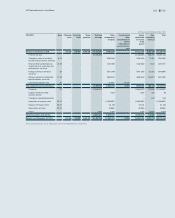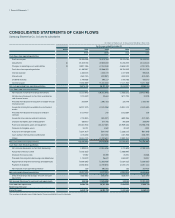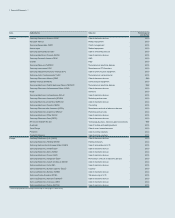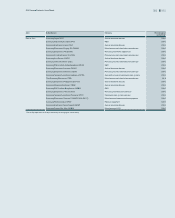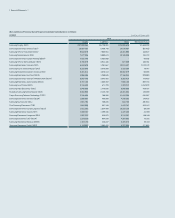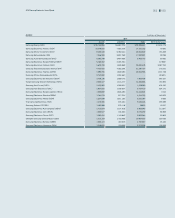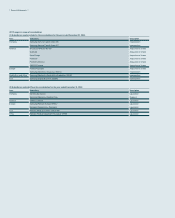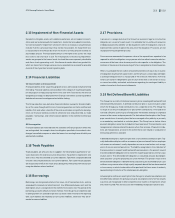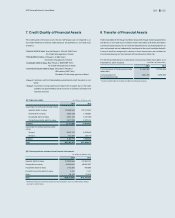Samsung 2014 Annual Report Download - page 57
Download and view the complete annual report
Please find page 57 of the 2014 Samsung annual report below. You can navigate through the pages in the report by either clicking on the pages listed below, or by using the keyword search tool below to find specific information within the annual report.
055054
2014 Samsung Electronics Annual Report2014 Samsung Electronics Annual Report
2. Summary of Significant Accounting
Policies
The principal accounting policies applied in the preparation of these consolidated
financial statements are set out below. These policies have been consistently ap-
plied to all the years presented, unless otherwise stated.
2.1 Basis of Presentation
The Group maintains its accounting records in Korean won and prepares statu-
tory financial statements in the Korean language (Hangul) in accordance with the
International Financial Reporting Standards as adopted by the Republic of Korea
(“Korean IFRS”). The accompanying consolidated financial statements have been
condensed, restructured and translated into English from the Korean language
financial statements.
Certain information attached to the Korean language financial statements, but not
required for a fair presentation of the Group’s financial position, financial perfor-
mance or cash flows, is not presented in the accompanying consolidated financial
statements.
The consolidated financial statements of the Group presented have been pre-
pared in accordance with Korean IFRS. International Financial Reporting Stan-
dards (“IFRS”) have been adopted by the Korean Accounting Standards Board as
Korean IFRS based on standards and interpretations published by the Internation-
al Accounting Standards Board.
Korean IFRS permits the use of critical accounting estimates in the preparation
of the financial statements and requires management judgments in applying ac-
counting policies. The areas involving a higher degree of judgment or complexity,
or areas where assumptions and estimates are significant to the consolidated
financial statements, are disclosed in Note 3.
2.2 Changes in Accounting Policy and
Disclosures
(A) New and amended standards adopted by the Group
The Group applied the following amended and enacted standards for the annual
period beginning on January 1, 2014:
Amendment to Korean IFRS 1032, Financial Instruments: Presentation
Amendment to Korean IFRS 1032, Financial Instruments: Presentation, provides
that the right to offset must not be contingent on a future event and must be le-
gally enforceable in all of circumstances; and if an entity can settle amounts in a
manner such that the outcome is, in effect, equivalent to net settlement, the entity
will meet the net settlement criterion. The adoption of this standard did not have a
material impact on the consolidated financial statements.
Enactment of Korean IFRS 2121, Levies
Korean IFRS 2121, Levies, is applied to a liability to pay a levy imposed by the
government in accordance with the legislation. The interpretation requires that the
liability to pay a levy is recognized when the activity that triggers the payment of
the levy occurs (obligating event), as identified by the legislation. The application
of this interpretation did not have a material impact on the consolidated financial
statements.
(B) New and amended standards not adopted by the Group
The Group expects that new standards, amendments and interpretations issued
but not effective for the financial year beginning January 1, 2014, and not early ad-
opted, would not have a material impact on its consolidated financial statements.
2.3 Consolidation
The Group prepares the consolidated financial statements in accordance with
Korean IFRS 1110, Consolidated Financial Statements.
(A) Subsidiaries
Subsidiaries are all entities (including special purpose entities) over which the
Group has control. The Group controls the corresponding investee when it is
exposed, or has rights, to variable returns from its involvement with the investee
and has the ability to affect those returns through its power over the investee.
Consolidation of a subsidiary begins from the date the Group obtains control of a
subsidiary and ceases when the Group loses control of the subsidiary.
The Group applies the acquisition method to account for business combinations.
The consideration transferred is measured at the fair values of the assets trans-
ferred, and identifiable assets acquired and liabilities and contingent liabilities
assumed in a business combination are initially measured at their fair values
at the acquisition date. The Group recognizes any non-controlling interest in
the acquiree on an acquisition-by-acquisition basis in the event of liquidation at
the non-controlling interest’s proportionate share of the recognized amounts of
acquiree’s identifiable net assets. Acquisition-related costs are expensed as in-
curred.
Goodwill is recognized as the excess of (1) the aggregate of i) the consideration
transferred, ii) the amount of any non-controlling interest in the acquiree and iii) the
acquisition-date fair value of the Group’s previously held equity interest in the ac-
quiree over (2) the net identifiable assets acquired. If this consideration (1) is lower
than the fair value of the acquiree’s net assets in (2), the difference is recognized
in profit or loss.
Balances of receivables and payables, income and expenses and unrealized
gains on transactions between the Group subsidiaries are eliminated. Accounting
policies of subsidiaries are changed where necessary to ensure consistency with
the policies adopted by the Group.
(B) Changes in ownership interests in subsidiaries without change of control
Transactions with non-controlling interests that do not result in loss of control are
accounted for as equity transactions – that is, as transactions with the owners in
their capacity as owners. The difference between fair value of any consideration
paid and the relevant share acquired of the carrying value of net assets of the
subsidiary is recorded in equity. Gains or losses on disposals of non-controlling
interests are also recorded in equity.


